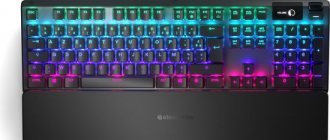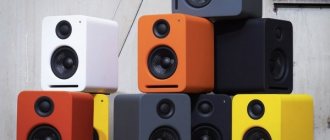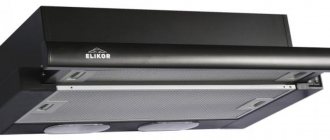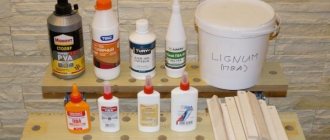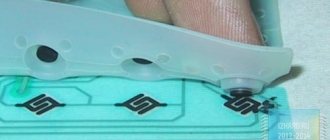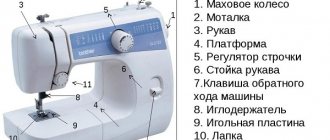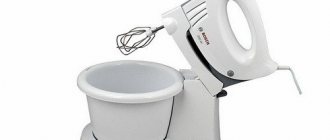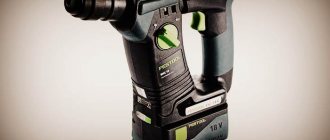Principle of operation
All switches, or switches as they are called, are designed according to the same principle. In the initial position of the button, the contact that activates the character set remains open. When pressed, the key moves the contact-retaining plunger.
It, unbending, closes, and the keyboard controller receives a signal that the key is activated.
The main difference between all switches is the resistance force holding the spring button and the interaction between the cup and plunger.
By simulating various types of interaction of these elements, designers can implement a device with any parameters: from an almost silent switch, triggered by a key stroke of a few millimeters, to a keyboard that completely imitates an old typewriter - with a corresponding rumble during operation and tactile sensations.
And now about popular types of switches.
Operating principle of switches
In a mechanical keyboard, each key is equipped with a separate switch, consisting of a housing, a chassis with a return spring and the contact itself. It is in the design that the main difference between the mechanics and inexpensive membrane devices, in which the keycaps are located on rubber domes, lies.
Using a variety of modifications of switches, manufacturers produce peripherals with any parameters: from almost silent keyboards with switches that are activated by a few millimeters of key travel, to devices that resemble antique typewriters in tactile and sound sensations.
In the initial position, the button contact responsible for typing the character remains open. When pressed, the metal wires connect to each other, thereby completing an electrical circuit and sending the PC information about which button was pressed. The closure occurs in the middle of the stroke, so you do not need to press the key all the way to operate. After releasing the key, the rod returns to its place under the action of the spring and opens the contacts.
There are 2 types of switches:
- linear - the quietest switches that are easy to press and do not have any kickback;
- tactile – louder clicking switches with well-felt tactile feedback.
In general, we can say that the main differences between these types of switches are the force that must be applied when pressing the button, as well as the travel of the key and the sound when activated.
Useful: How to properly remove a key from a mechanical keyboard
Cherry MX
Produced in Germany since 1983. In fact, the company has almost a monopoly, since such switches are used in the vast majority of mechanical keyboards.
This brand is recognized as the quality standard in the industry due to its trouble-free performance over a long period of time. There are several varieties:
- RGB. Switches in a transparent case. Used in most backlit keyboards.
- Brown. Tactile. The quietest in operation, with a clearly defined actuation point. Suitable for large volume typing or amateur gamers.
- Blue. Tactile, with a characteristic click. The sound of operation is reminiscent of a typewriter. For gaming, blue switches are not the best option due to the long key travel.
- Red. Linear. The favorite type of switches for most gamers, as they are “sharpened” for fast multiple clicks. They press much easier than previous options - a force of 45 g is enough. They are also suitable for work.
- Silent Red. Linear. Variation of the previous type. Almost silent during operation, which is achieved thanks to the presence of a noise-absorbing gasket in each switch. The tactile sensation is a little soft, which not all users like.
- Black. Linear. The most “tight” in the model range. Requires more force to press. On the other hand, black switches reduce the risk of accidental activation if pressed carelessly, which is why such switches are also popular among gamers.
- Clear. Tactile. Reminiscent of Brown, but with a more pronounced tactile response. Quite tight: they require up to 80g of force to activate. Recommended for experienced mechanical keyboard users.
- Green. Tactile clickers. Reminiscent of Blue, but equipped with a stiffer spring. Accidental clicks are excluded, so you can use it for gaming.
- Speed Silver. Linear. Essentially the same Red ones with a shortened key travel. The manufacturer positions them as the fastest switches, so they are suitable not only for games, but also for high-speed typing.
- Nature White. Linear. The target audience is gamers for whom red switch keyboards are too easy to press. The golden mean: a force of 50 grams is enough to trigger.
It is worth noting that the color of the switches is not a marketing name: they are actually colored according to the name, so it is not difficult to distinguish them.
Cherry MX BLUE
Cherry MX BLUE is a lightweight switch. Unlike most other switches, the plunger in this one consists not of one, but of two parts:
- blue plunger (which is connected to the key);
- white inner slider (which opens and closes the outline).
These switches emit a characteristic click, which does not depend in any way on the presence of a keycap. The answer to the question of how blue switches differ from red ones is extremely simple - blue ones have higher rigidity than red ones, as well as a slightly longer stroke. Therefore, for the mechanism to work, a force of 60 grams must be applied.
MX BLUE allows you to clearly feel and also hear the moment when the mechanism worked, however, you will not have the same control in games as with red and brown switches. In general, these switches are still great for gaming, because the gamer will clearly understand whether the press worked or not. The blue type of switches is an ideal option for those whose priority is not gaming, but typing.
Topre
The Japanese brand has been producing electrostatic capacitive switches since 1983. According to user reviews, keyboards with these switches last for decades. The structure can be described as hybrid: in addition to the spring, the structure contains an elastic membrane.
The tactile sensations are more reminiscent of expensive membrane keyboards.
The key travel is smooth and soft, and the actuation point is located at the very beginning of the button travel. When pressed all the way, the switch makes a characteristic click. They sound pleasant, and at the same time they are quieter than most mechanical switches.
Cherry MX RED
Cherry MX RED are linear switches that have no click, making them unusually quiet. At the same time, they lack tactile feedback, so they are also very smooth.
This type allows you to instantly respond to events in games. This is the highlight of the mechanics: the ability to easily control the process and response speed. The pressing force to activate this switch is about 40 grams. In principle, these are very light switches, and you can play them for quite a long time without getting your fingers tired.
One of the disadvantages is the sound, that is, the reproduced volume. How can they be loud if they are linear and have no click? Everything is very simple! Due to the fact that the pressing force is very small, when the keycap is bent onto the switch, it comes into contact with the plastic of the switch itself and produces a characteristic sound. It follows from this that red switches without a keycap are quite quiet, but as soon as you put on a keycap, the sound turns out to be two or even three times louder.
ALPS
Such switches were produced by the Japanese company of the same name until 1996. Today, all switches of this brand are exact copies of products from a famous brand. They have a rather complex design: up to 10 components in each switch.
There are various modifications: tactile, linear, clicking and silent. The most famous products today are from Matias, which are simplified versions of ALPS switches.
And despite the fact that the original keyboards of this brand have not been produced for a long time, you can find used ALPS in excellent condition on the Internet - for example, on eBay.
ALPS SKCL/SKCM
ALPS switches for mechanical keyboards were produced by the Japanese company of the same name until 1996. Currently, all switches calling themselves ALPS or Alps are, to varying degrees of accuracy, copies of those same old ALPS. The original switches are often referred to in foreign sources as “Alps Complicated” (complicated), due to the design consisting of 10 parts per switch. There were linear, tactile, clicky and other options for Alps switches.
The most popular clones at the moment are switches from Matias, the design of which is greatly simplified compared to the original. If you are not an enthusiast, then there is no point in paying attention to other clones.
ALPS (and similar ones) can be a great alternative to Cherry MX switches: if you like tactility and want something more than Cherry MX Brown and Cherry MX Clear, then ALPS is the way to go.
Despite the fact that ALPS switches for mechanical keyboards are no longer produced, if you want and are persistent enough, you can find keyboards in good condition on the Internet, for example on ebay.
- Experimenters
- For those for whom Cherry MX is “something not right”
- To broaden your horizons
- To the home collection
Matias
These switches are assembled in China, at the Dongguan Gaote Electronics plant. There are several modifications:
- Click. Tactile clickers. Not the quietest, so not suitable for users who are annoyed by loud sound. Suitable for lovers of nostalgia or fans of old typewriters.
- Quiet Click. Tactile. The sound is as quiet as membrane keyboards.
Linear. Linear. They have a smoother and tighter click compared to Cherry MX SilentRed and are popular with many gamers.
Cherry MX BROWN
Cherry MX BROWN - refers to tactile switches that do not have a characteristic click. The switch is not pressed evenly and has a characteristic cutoff, that is, you can feel it when you press the switch. The approximate pressing force is 45 grams, which is the most optimal. These switches are used to produce HyperX, Extra RGB and other brethren. Cherry MX BROWN is one of the most optimal switches for video games and text typing because they:
- quiet, as they do not have any clicks or clicks;
- very comfortable due to their tactile sensations and feedback.
Kailh
Inexpensive Chinese clones of Cherry MX switches. Recently appeared on the market, therefore not well tested. Often, keyboards equipped with these switches experience problems with keys rattling or double-acting.
However, for such a price it is difficult to expect perfect performance.
They are installed in inexpensive mechanical keyboards, costing 30–40 dollars. As a rule, they are not used in premium models.
Cherry MX switches
First introduced on November 7, 1983 by the German company Cherry. Initially, only linear switches were available. Subsequently, the variety of switches was achieved by combining pressing force, the presence or absence of tactile feedback, and the presence/absence of a click. Visually, the switches are distinguished by stem color.
Cherry MX switches are the de facto quality standard in the industry. Gold-plated contacts do not oxidize over time; they can be poured over with coffee, cola and other drink of your choice, then rinsed under running water, dried well and used further.
During production, special attention is paid to accuracy and precision, which avoids failures, breakdowns, double clicks, rattling and other unpleasant features found in cheap Chinese clones.
Razer
The hegemonic leader, who set his sights on being the leader in the creation of gaming devices, abandoned the products of other brands and uses his own switches in mechanical keyboards.
This is due not only to the fact that the brand wants to be on its own, but also to the fact that Cherry’s production capacity was not enough for Razer’s growing appetites. There are several types of switches of this brand:
- Green – tactile, with a pronounced click;
- Yellow – linear, with shortened key travel;
- Orange – tactile, with a quiet click.
